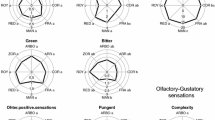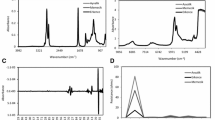Abstract
An authentication study of the Italian PDO (protected designation of origin) olive oil Chianti Classico, based on near-infrared and UV–Visible spectroscopy, an artificial nose and an artificial tongue, with a set of samples representative of the whole Chianti Classico production and a considerable number of samples from a close production area (Maremma) was performed. The non-specific signals provided by the four fingerprinting analytical techniques, after a proper pre-processing, were used for building class models for Chianti Classico oils. The outcomes of classical class-modelling techniques like soft independent modelling of class analogy and quadratic discriminant analysis—unequal dispersed classes were compared with those of two techniques recently introduced into Chemometrics: multivariate range modelling and CAIMAN analogues modelling methods.








Similar content being viewed by others
References
Luykx DMAM, van Ruth SM (2008) Food Chem 107:897–911
Dimara E, Skuras D (2003) Eur J Market 37:690–705
European Council Regulation No 510/2006 of 20 Mar 2006
European Commission Regulation No 2446/2000 of 6 Nov 2000
Ministero delle Politiche Agricole e Forestali, Provvedimento of 4 Dec 2000, Gazzetta Ufficiale della Repubblica Italiana No 13 of 17 Jan 2001
Armanino C, Leardi R, Lanteri S, Modi G (1989) Chemom Intell Lab Syst 5:343–354
Ollivier D, Artaud J, Pinatel C, Durbec JP, Guérère M (2006) Food Chem 97:382–393
Lerma-García MJ, Herrero-Martínez JM, Ramis-Ramos G, Simó-Alfonso EF (2008) Food Chem 108:1142–1148
Valcárcel M, Cárdenas S (2005) Trends Anal Chem 24:67–74
Sinelli N, Casiraghi E, Tura D, Downey G (2007) J Near Infrared Spectrosc 16:335–342
Forina M, Boggia R, Casale M (2007) Ann Chim (Rome) 97:615–633
Cosio MS, Ballabio D, Benedetti S, Gigliotti C (2006) Anal Chim Acta 567:202–210
Oliveri P, Baldo MA, Daniele S, Forina M (2009) Anal Bioanal Chem 395:1135–1143
Forina M, Oliveri P, Lanteri S, Casale M (2008) Chemom Intell Lab Syst 93:132–148
Cerrato-Oliveros C, Boggia R, Casale M, Armanino C, Forina M (2005) J Chromatogr A 1076:7–15
Barnes RJ, Dhanoa MS, Lister SJ (1989) Appl Spectrosc 43:772–777
Jolliffe IT (2002) Principal component analysis. Springer series in statistics, 2nd edn. Springer, New York
Wold S, Sjöström M (1977) Chemometrics: theory and applications. In: Kowalski BR (ed) Chemometrics: theory and application, ACS Symposium Series 52. American Chemical Society, Washington, pp 243–282
Hotelling H (1947) Multivariate quality control. In: Eisenhart C, Hastay MW, Wallis WA (eds) Techniques of statistical analysis. McGraw-Hill, New York, pp 111–184
Derde MP, Massart DL (1986) Anal Chim Acta 184:33–51
Forina M, Oliveri P, Casale M, Lanteri S (2008) Anal Chim Acta 622:85–93
Forina M, Casale M, Oliveri P, Lanteri S (2009) Chemom Intell Lab Syst 96:239–245
Forina M, Lanteri S, Armanino C, Casolino C, Casale M, Oliveri P (2009) V-PARVUS 2009, University of Genoa, Genoa. http://www.parvus.unige.it. Accessed 2 Jan 2010
Harper AM, Duewer DL, Kowalski BR, Fashing JL (1977) In: Kowalski BR (ed) Chemometrics: theory and application, ACS Symposium Series 52. American Chemical Society, Washington, pp 14–52
Acknowledgments
Financial support by the Italian Ministry of University and Research (MIUR) and by the University of Genoa is gratefully acknowledged.
Author information
Authors and Affiliations
Corresponding author
Additional information
Published in the special issue Chemometrics (VII Colloquium Chemiometricum Mediterraneum) with Guest Editors Marcelo Blanco, Juan M. Bosque-Sendra and Luis Cuadros-Rodríguez.
Rights and permissions
About this article
Cite this article
Oliveri, P., Casale, M., Casolino, M.C. et al. Comparison between classical and innovative class-modelling techniques for the characterisation of a PDO olive oil. Anal Bioanal Chem 399, 2105–2113 (2011). https://doi.org/10.1007/s00216-010-4377-1
Received:
Revised:
Accepted:
Published:
Issue Date:
DOI: https://doi.org/10.1007/s00216-010-4377-1




